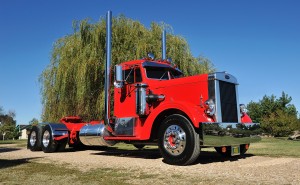 Finding a perfect truck these days is not all that rare. Finding a rare truck that is perfect, now that is a little less common – but we did. Steve Moss (36) of Colgate, Wisconsin purchased this 1952 Peterbilt 350 six years ago, and since less than 850 of them were ever produced, they are considered to be very rare finds these days. When Steve found this truck, it had been rebuilt (sort of) and the cab had been put on a newer chassis and drivetrain – Steve thought he could clean it up a bit and then use it as a spare truck. But once the “clean-up” project began, it quickly became a full frame-up restoration. Today, this perfect rig is just a “hobby truck” that Steve enjoys taking to shows from time to time, but it has a pretty colorful history.
Finding a perfect truck these days is not all that rare. Finding a rare truck that is perfect, now that is a little less common – but we did. Steve Moss (36) of Colgate, Wisconsin purchased this 1952 Peterbilt 350 six years ago, and since less than 850 of them were ever produced, they are considered to be very rare finds these days. When Steve found this truck, it had been rebuilt (sort of) and the cab had been put on a newer chassis and drivetrain – Steve thought he could clean it up a bit and then use it as a spare truck. But once the “clean-up” project began, it quickly became a full frame-up restoration. Today, this perfect rig is just a “hobby truck” that Steve enjoys taking to shows from time to time, but it has a pretty colorful history.
Steve was born and raised in Wisconsin. His dad, Jack Moss, started trucking in the early 1970s, and as soon as Steve was old enough, he began going out on runs with him. Back in those days, Jack drove a cabover Kenworth for Highway Transit (Steve logged a lot of miles in the right seat of that old cabover). In 1980, Jack bought his first truck – a 1974 Pete 359 short hood with a 30” sleeper – and in 1989, he bought his first new Peterbilt from the local dealer in Green Bay. Steve remembers going to pick that new truck up with his dad. At only 13 years old, Steve drove it all the way home in the snow. His dad told him, “Put on a hat, it makes you look older!”
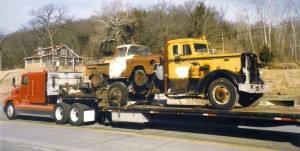 At 14 years old, Steve started working at a local company called Tank Transport, first just washing trucks, then eventually doing brake jobs, servicing trailers, and doing whatever else needed to be done. Steve worked there for four years. When Steve was 17, his dad dragged him out to Whitelaw, WI one night to go look at a truck – Steve just figured it was for his dad, and was not happy about having to go. But when he saw the dark green Peterbilt 359 with a small bunk and a long hood sitting there, Steve fell in love. And when his dad asked him if he wanted to buy it – for himself – Steve really went crazy.
At 14 years old, Steve started working at a local company called Tank Transport, first just washing trucks, then eventually doing brake jobs, servicing trailers, and doing whatever else needed to be done. Steve worked there for four years. When Steve was 17, his dad dragged him out to Whitelaw, WI one night to go look at a truck – Steve just figured it was for his dad, and was not happy about having to go. But when he saw the dark green Peterbilt 359 with a small bunk and a long hood sitting there, Steve fell in love. And when his dad asked him if he wanted to buy it – for himself – Steve really went crazy.
Jack financed the truck for his son with the stipulation that he would sign on at Best Block, where he was leased to, and stay there until the truck was paid for. Steve agreed, and on his 18th birthday, got his CDL and then started trucking. Later, Steve realized that his dad, probably trying to keep him out of harm’s way, had “steered” him into trucking with this deal, because Steve had planned on joining the Marines after high school. Jack is famous for booting Steve in the butt when he feels that he is going in the wrong direction or about to make a dumb decision, but he does it without ever saying anything directly or telling him what to do. Needless to say, once Steve started trucking, he never looked back – and Jack probably knew that’s what would happen.
 That first truck, a 1984 Pete 359 long hood, was a pretty cool ride – even by today’s standards. Featuring a 220-inch wheelbase, dark green paint, dual aluminum tanks, 6-inch exhaust with Pickett-style elbows, dual round headlights, all aluminum wheels, and a 36-inch sleeper with brown interior, it sounds like something straight out of today’s “old school” truck file. Signing on at Best Block like he promised, Steve began delivering concrete block locally to homes and commercial building sites with a boom trailer (so he could unload himself). Steve worked hard to pay that truck off as quickly as possible, but once he did, he just kept trucking with it.
That first truck, a 1984 Pete 359 long hood, was a pretty cool ride – even by today’s standards. Featuring a 220-inch wheelbase, dark green paint, dual aluminum tanks, 6-inch exhaust with Pickett-style elbows, dual round headlights, all aluminum wheels, and a 36-inch sleeper with brown interior, it sounds like something straight out of today’s “old school” truck file. Signing on at Best Block like he promised, Steve began delivering concrete block locally to homes and commercial building sites with a boom trailer (so he could unload himself). Steve worked hard to pay that truck off as quickly as possible, but once he did, he just kept trucking with it.
When Steve was 21 years old, he bought a flatbed and started hauling steel coils, in addition to the block, out of state. In the meantime, his dad had got his own authority, so Steve signed on with him – but both were still hauling for Best Block (and other companies). A few years 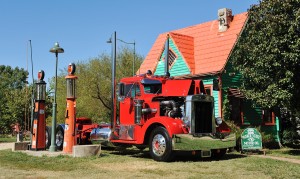 later, Steve signed a lucrative contract with Coca-Cola and started Steven J. Moss Trucking. Running his one truck and signing-on six owner-operators, this contract kept him hustling for seven years, hauling various Coca-Cola products back and forth between production centers in Milwaukee and Chicago. Then, as it always goes, they asked Steve to cut his rate after another carrier (actually a broker) had came in with a much lower bid. Steve said, “Sorry, but no!” and moved on.
later, Steve signed a lucrative contract with Coca-Cola and started Steven J. Moss Trucking. Running his one truck and signing-on six owner-operators, this contract kept him hustling for seven years, hauling various Coca-Cola products back and forth between production centers in Milwaukee and Chicago. Then, as it always goes, they asked Steve to cut his rate after another carrier (actually a broker) had came in with a much lower bid. Steve said, “Sorry, but no!” and moved on.
About this time, Steve and his wife started having babies, and he really didn’t want to go long-haul trucking, but he was prepared to do so, if he had to. Then his dad made him a little proposition. Looking to semi-retire and start slowing down at his own company, Jack C. Moss Trucking, his dad offered him a position that would require him to take care of the trucks (14 of them) and trailers, schedule loads, do office work, and handle any “emergencies” that crop up. After accepting the offer, Steve realized that his dad had “kicked him in the butt” once again (going trucking with a new family at home would not have been a good decision).
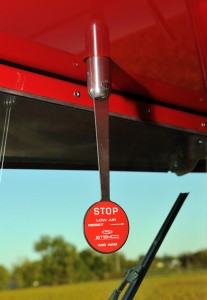 Hauling mostly food-grade steel coils destined to be cans for various food products, Jack C. Moss Trucking primarily runs in and around the states of Wisconsin, Illinois, Indiana, Michigan and Minnesota. With one of the nicest fleets in the area, boasting all long-hood Peterbilt 379s (and two 389s) with owner-operator specs, nice paint jobs and extra chrome, Jack C. Moss Trucking is known for hiring only the best of the best drivers. They do not advertise for drivers, instead relying on word of mouth and personal referrals. Steve said, “Our lowest rated driver is probably 90 times better than most company’s best drivers.” On the weekends, when all of the trucks have been washed and are parked in the yard, it looks like a truck show is going on! Steve loves the newer Peterbilts, but he has always had a soft spot in his heart for old trucks – which brings us to his 1952 “Iron Nose” Peterbilt.
Hauling mostly food-grade steel coils destined to be cans for various food products, Jack C. Moss Trucking primarily runs in and around the states of Wisconsin, Illinois, Indiana, Michigan and Minnesota. With one of the nicest fleets in the area, boasting all long-hood Peterbilt 379s (and two 389s) with owner-operator specs, nice paint jobs and extra chrome, Jack C. Moss Trucking is known for hiring only the best of the best drivers. They do not advertise for drivers, instead relying on word of mouth and personal referrals. Steve said, “Our lowest rated driver is probably 90 times better than most company’s best drivers.” On the weekends, when all of the trucks have been washed and are parked in the yard, it looks like a truck show is going on! Steve loves the newer Peterbilts, but he has always had a soft spot in his heart for old trucks – which brings us to his 1952 “Iron Nose” Peterbilt.
The story of Steve’s 1952 Peterbilt 350 starts some 20 years ago, and it involves our friend and writer/contributor Clint Moore. A man named George Brinkman from Chickasha, OK came to the dealership Clint was working at, wanting to know if Clint wanted to buy his Volvo. George even had a picture of it. After looking at it, Clint said, “Nah, I don’t want to buy the Volvo, but I’ll buy that old Peterbilt sitting in the background behind it.” All Clint could see was the back of the truck, but he saw the sliding rear window and knew it was an old 1950s Peterbilt. George did not want to sell the Peterbilt and went on his way, but Clint was persistent. Calling George at least once a year for several years to ask him again, Clint finally got him to agree to sell the Pete.
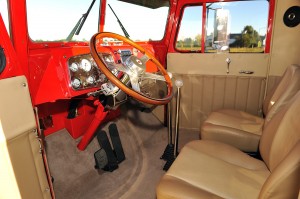 When Clint went to pick the truck up, he found something else he liked – a limited edition 1956 Chevy Cameo pickup. Clint made George an offer for both and the deal was done – George even offered to put the pickup on the Peterbilt’s frame rails and deliver both of them together. One of the photos here shows exactly what the Peterbilt and pickup looked like when George delivered them to Clint in 1996 (Clint still has the pickup today, and is slowly rebuilding it). Not looking to keep the Peterbilt, Clint quickly found a buyer – Brian Near, a farmer from Illinois. Brian took the old truck apart and placed the cab on a newer chassis with a newer drivetrain and then ran it for several years, until finally deciding to sell it. About that same time, Steve just happened to contact Clint, looking for some nice old iron – so Clint referred Steve to Brian.
When Clint went to pick the truck up, he found something else he liked – a limited edition 1956 Chevy Cameo pickup. Clint made George an offer for both and the deal was done – George even offered to put the pickup on the Peterbilt’s frame rails and deliver both of them together. One of the photos here shows exactly what the Peterbilt and pickup looked like when George delivered them to Clint in 1996 (Clint still has the pickup today, and is slowly rebuilding it). Not looking to keep the Peterbilt, Clint quickly found a buyer – Brian Near, a farmer from Illinois. Brian took the old truck apart and placed the cab on a newer chassis with a newer drivetrain and then ran it for several years, until finally deciding to sell it. About that same time, Steve just happened to contact Clint, looking for some nice old iron – so Clint referred Steve to Brian.
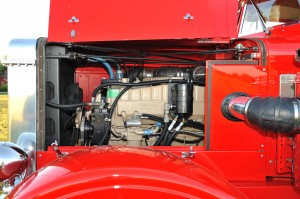 Once Steve went to look at the truck and realized that it was a rare “Iron Nose” Peterbilt 350, he bought it and took it home. The “Iron Nose” was produced between 1949 and 1957, and only 847 of them were ever made. From 1949 to 1954 the cabs were fabricated entirely of steel, and then from 1954 to 1957 the cabs were made out of aluminum. So, this was a nice, rare find for Steve. At that time, the truck was red with a black roof cap and fenders, and it ran pretty good, it just needed a little TLC. Steve’s original intentions were to clean it up, rewire it, and then use it as a spare truck. He took it to a friend to do the work, but one delay led to another, and two years later, it was still just sitting there taking up space.
Once Steve went to look at the truck and realized that it was a rare “Iron Nose” Peterbilt 350, he bought it and took it home. The “Iron Nose” was produced between 1949 and 1957, and only 847 of them were ever made. From 1949 to 1954 the cabs were fabricated entirely of steel, and then from 1954 to 1957 the cabs were made out of aluminum. So, this was a nice, rare find for Steve. At that time, the truck was red with a black roof cap and fenders, and it ran pretty good, it just needed a little TLC. Steve’s original intentions were to clean it up, rewire it, and then use it as a spare truck. He took it to a friend to do the work, but one delay led to another, and two years later, it was still just sitting there taking up space.
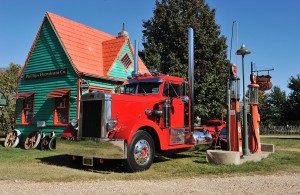 About two years ago, Steve took the truck to his friend Kenny Weber, owner of Ken Weber Truck Service, to finish the rewiring job and get it running again. Once Kenny started tearing things apart, again, one thing led to another, and they decided to tear the entire truck down to the bare frame rails, remove every bolt, and do a complete restoration. The first thing they did was stretch the frame from 208 inches to 265 inches. After the stretched rails were painted Viper Red, the chassis, including the cross-members and suspension, was bolted back together, and then everything was painted again. They freshened up the 400 Big Cam III Cummins engine and 13-speed transmission, but everything inside looked good so they did not rebuild them.
About two years ago, Steve took the truck to his friend Kenny Weber, owner of Ken Weber Truck Service, to finish the rewiring job and get it running again. Once Kenny started tearing things apart, again, one thing led to another, and they decided to tear the entire truck down to the bare frame rails, remove every bolt, and do a complete restoration. The first thing they did was stretch the frame from 208 inches to 265 inches. After the stretched rails were painted Viper Red, the chassis, including the cross-members and suspension, was bolted back together, and then everything was painted again. They freshened up the 400 Big Cam III Cummins engine and 13-speed transmission, but everything inside looked good so they did not rebuild them.
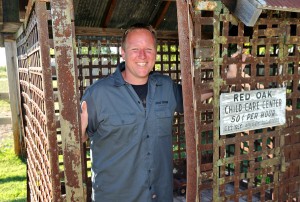 The cab was in pretty good shape, but they still had to do a little work on it. Someone (probably Brian) had already replaced the original fenders with a set of fiberglass ones, which was good, because they are no longer available for this model. The entire rig was completely rewired – every wire is brand new, and there are only two butt connectors on the entire unit. The steel butterfly hood was a little rough (and a little heavy), so Steve had new aluminum side panels made. In addition to replacing the radiator, the grille shutters were wired to open and close based on the engine temperature. Mounted on top of the hood, Steve found an original hood ornament, which turned out to be the hardest piece on the truck to find (he found it on e-bay and got it for only $50). Every bolt on this truck was touched or changed, and every bolt matches – and, as if that wasn’t enough, all of the visible bolts were “clocked” (the heads were turned to face the same direction).
The cab was in pretty good shape, but they still had to do a little work on it. Someone (probably Brian) had already replaced the original fenders with a set of fiberglass ones, which was good, because they are no longer available for this model. The entire rig was completely rewired – every wire is brand new, and there are only two butt connectors on the entire unit. The steel butterfly hood was a little rough (and a little heavy), so Steve had new aluminum side panels made. In addition to replacing the radiator, the grille shutters were wired to open and close based on the engine temperature. Mounted on top of the hood, Steve found an original hood ornament, which turned out to be the hardest piece on the truck to find (he found it on e-bay and got it for only $50). Every bolt on this truck was touched or changed, and every bolt matches – and, as if that wasn’t enough, all of the visible bolts were “clocked” (the heads were turned to face the same direction).
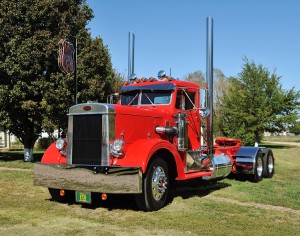 The entire restoration project took two years to complete. When it was all said and done, the Viper Red truck, which was painted by T/A Truck Painting in Pewaukee, WI, also had Hogebuilt half fenders, a one-piece stainless deck plate that is 12 feet long, a brand new Holland 5th wheel, 6-inch exhaust and a tapered Valley Chrome bumper. There is a simple light bar mounted on the back of the truck, five bullet lights and two horns on the roof, and all of the glass is brand new. The exterior of this classic Peterbilt is simple and clean, and the interior is equally (if not more) impressive.
The entire restoration project took two years to complete. When it was all said and done, the Viper Red truck, which was painted by T/A Truck Painting in Pewaukee, WI, also had Hogebuilt half fenders, a one-piece stainless deck plate that is 12 feet long, a brand new Holland 5th wheel, 6-inch exhaust and a tapered Valley Chrome bumper. There is a simple light bar mounted on the back of the truck, five bullet lights and two horns on the roof, and all of the glass is brand new. The exterior of this classic Peterbilt is simple and clean, and the interior is equally (if not more) impressive.
Making all new panels covered in tan and brown leather, Straight Line Interiors in Sussex, WI did much of the work on the truck’s interior. Jerry at T/A Truck Painting also built a custom header console above the windshield to house the stereo and CB out of the way, and to keep the dash clean. All new gauges were installed, and any extra holes in the dash were filled and painted. The 13-speed transmission was fitted with a 12 Gauge two-stick conversion setup, and then two classic glitter ball knobs were placed atop the twin shifters. Under the dash, the new wiring was left exposed, partly for that “stock” look, and partly because it looked so nice.
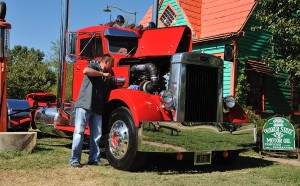 Up on the new header console, there is also a classic “wig wag” low air warning device, which was a stock feature on this truck when it was new. When the air pressure drops below a certain point, a small arm with a round “stop” sign on the end of it swings down in front of the driver’s face, warning of the problem. Once the air pressure builds back up, the driver manually resets the “wig wag” arm by swinging it back up and locking it into place.
Up on the new header console, there is also a classic “wig wag” low air warning device, which was a stock feature on this truck when it was new. When the air pressure drops below a certain point, a small arm with a round “stop” sign on the end of it swings down in front of the driver’s face, warning of the problem. Once the air pressure builds back up, the driver manually resets the “wig wag” arm by swinging it back up and locking it into place.
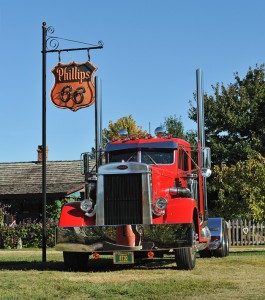 Because this truck sits on a newer chassis, has a newer drivetrain and a brand new interior, it drives nice and smooth and is very comfortable. In fact, when Steve brought it down to Joplin, MO for the show held there last October, he did not trailer the truck down – he drove it – and he rode over 600 miles without stopping. He also drove it down to Denton, TX for the annual show held there at the Peterbilt plant. When we met Steve, he had just collected his “Best of Show Bobtail” award in Joplin and he was pretty happy (this was his first Best of Show ever). We made plans to meet up with him the next morning for a photo shoot at a neat place called Red Oak II.
Because this truck sits on a newer chassis, has a newer drivetrain and a brand new interior, it drives nice and smooth and is very comfortable. In fact, when Steve brought it down to Joplin, MO for the show held there last October, he did not trailer the truck down – he drove it – and he rode over 600 miles without stopping. He also drove it down to Denton, TX for the annual show held there at the Peterbilt plant. When we met Steve, he had just collected his “Best of Show Bobtail” award in Joplin and he was pretty happy (this was his first Best of Show ever). We made plans to meet up with him the next morning for a photo shoot at a neat place called Red Oak II.
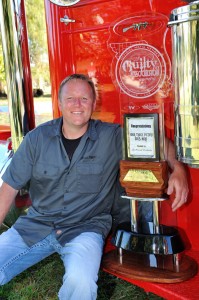 Red Oak II was the brainchild of an artist named Lowell Davis, who grew up in the “real” town of Red Oak, Missouri, about 20 miles north of the “new” Red Oak II. Like many other rural towns across the country, Red Oak started to fade away after World War II, when people began to migrate into the cities. After Davis had left the area for a number of years, he returned to find his home town was now a ghost town. In 1987, he began to buy homes and businesses from the original town site and other nearby rural ghost towns and then painstakingly moved them to his farm in Carthage, MO, thus creating Red Oak II. Today, this quaint ghost town includes an old schoolhouse, feed store, church, diner, town hall, jail and several homes, not to mention the cool 1920’s Phillips 66 gas station, where we took several of our pictures. This station was originally located on Route 66 in Avilla, MO. We’d like to thank Jed and Theresa, some of our friends from Missouri, for all of their help at the photo shoot.
Red Oak II was the brainchild of an artist named Lowell Davis, who grew up in the “real” town of Red Oak, Missouri, about 20 miles north of the “new” Red Oak II. Like many other rural towns across the country, Red Oak started to fade away after World War II, when people began to migrate into the cities. After Davis had left the area for a number of years, he returned to find his home town was now a ghost town. In 1987, he began to buy homes and businesses from the original town site and other nearby rural ghost towns and then painstakingly moved them to his farm in Carthage, MO, thus creating Red Oak II. Today, this quaint ghost town includes an old schoolhouse, feed store, church, diner, town hall, jail and several homes, not to mention the cool 1920’s Phillips 66 gas station, where we took several of our pictures. This station was originally located on Route 66 in Avilla, MO. We’d like to thank Jed and Theresa, some of our friends from Missouri, for all of their help at the photo shoot.
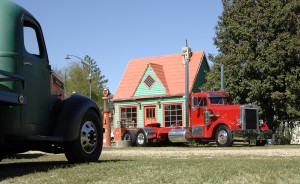 Steve and his wife Michele have been married for almost five years and have two young daughters – Mackenzie (4) and Breanna (almost 1). Michele recently stopped working to become a stay-at-home mom and loves being home with their girls. Michele is not a “truck nut” like Steve, but she respects and appreciates all that trucking has done for her family – so she puts up with it! When Steve is not working on trucks or playing with the kids, he likes to work on hot rods with his dad, who has several 1950’s Chevys. Steve has a 1940 Ford Coupe he is currently restoring and a 1984 one-ton dually that is slammed on the ground with a Big Block 468 (sporting about 650 horses) under the hood. He also still has his original 1984 Peterbilt 359.
Steve and his wife Michele have been married for almost five years and have two young daughters – Mackenzie (4) and Breanna (almost 1). Michele recently stopped working to become a stay-at-home mom and loves being home with their girls. Michele is not a “truck nut” like Steve, but she respects and appreciates all that trucking has done for her family – so she puts up with it! When Steve is not working on trucks or playing with the kids, he likes to work on hot rods with his dad, who has several 1950’s Chevys. Steve has a 1940 Ford Coupe he is currently restoring and a 1984 one-ton dually that is slammed on the ground with a Big Block 468 (sporting about 650 horses) under the hood. He also still has his original 1984 Peterbilt 359.
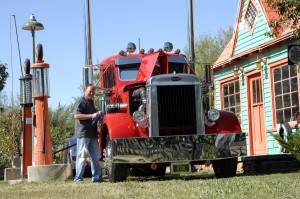 Steve Moss may not have found a perfect truck, but by the time he finished restoring the one he found, it certainly was. His beautiful (and extremely rare) 1952 Peterbilt 350 “Iron Nose” is about as perfect as it can get. We hope the next 60 years of this truck’s life are just as interesting and colorful as the first. Only time will tell. But, in the meantime, we all get to enjoy this rare breed of old Peterbilt perfection.
Steve Moss may not have found a perfect truck, but by the time he finished restoring the one he found, it certainly was. His beautiful (and extremely rare) 1952 Peterbilt 350 “Iron Nose” is about as perfect as it can get. We hope the next 60 years of this truck’s life are just as interesting and colorful as the first. Only time will tell. But, in the meantime, we all get to enjoy this rare breed of old Peterbilt perfection.

2 Comments
THIS IS ONE FRIGGING BEAUTY ! ALONG WITH THE NEAT HOUSE AND THE SMALL GAS STATION IN THE BACKGROUND IT SHOWS THAT THE OWNER HAS GOT A LOT OF STYLE. MAY YOUR RIDE WITH THIS ALWAYS BE A SMOOTH ONE !
Unreal nothin but class !!!!